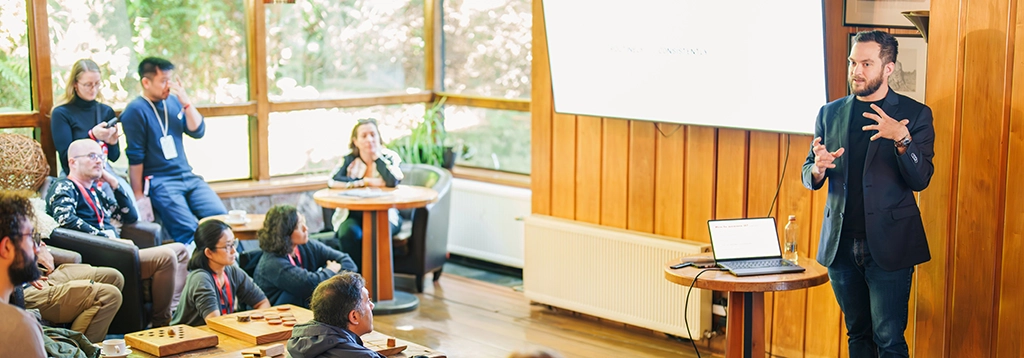Communicating Impact
When we think about communicating something, we often imagine it to be a smooth, straightforward task. After all, nearly every aspect of our daily lives is intertwined with some form of communication tool. In practice, this holds true: delivering a message to someone is generally simple. However, it’s crucial to remember that the effectiveness of what’s being communicated can vary significantly depending on the strategies, channels, and objectives supporting the message.
This is especially true when we talk about impactful communication. Sometimes, conveying the purpose of a social initiative or mission adds layers of complexity, as we’re shaping something that must influence and resonate with specific audiences. These audiences often require distinct stimuli and tones, demanding a voice refined by effective storytelling.
So, how can social entrepreneurs, volunteers, intrapreneurs, and benefactors around the world harness impactful communication strategies to drive their initiatives forward? What strategies and insights should be considered when crafting a checklist of actionable communication tactics? That's what we'll discuss today!
Understanding the Audience and Their Needs
One of the foundational steps in any impactful communication strategy is understanding the target audience in depth. For social entrepreneurs and nonprofits, this means moving beyond demographic details and tapping into the motivations, values, and specific concerns of the people and communities they aim to engage. To truly resonate, it’s helpful to consider questions such as: What challenges do they face that your initiative addresses? What beliefs or experiences do they hold that align with your mission? Empathy-driven research can inform the tone and content of your messages, helping to craft stories that connect on a personal level. Impactful communication is not one-size-fits-all; it's carefully tailored to reflect the unique perspectives of those you wish to inspire.
Crafting a Compelling Narrative
Effective storytelling is the heartbeat of impactful communication. When presenting social missions or initiatives, a well-constructed narrative can turn abstract concepts into tangible, emotionally engaging stories. A compelling story follows a basic structure, beginning by introducing a problem, presenting a solution, and then demonstrating the impact. For example, it can start with the problem that needs solving, outlining the social issue or need in a way that audiences can grasp and care about. Following this, the narrative highlights the solution, describing how the initiative addresses this need uniquely or effectively. Finally, the story showcases the impact by sharing real examples, testimonials, or measurable results that illustrate positive outcomes.
Real-life stories from individuals affected by your initiative bring a human element to the communication, making audiences feel connected to the mission on a personal level. This emotional connection helps motivate them to support or engage, making storytelling a core component of successful social impact communication.
Selecting the Right Channels
Each communication channel offers unique opportunities to engage audiences, so choosing the right ones is essential. Social media platforms like Instagram, Twitter, or LinkedIn provide immediate access to different demographics, each of which may respond differently depending on platform preferences and content style. Social media, for instance, is great for storytelling, sharing updates, and visual content that can be rapidly shared, amplifying reach when posts resonate with users. Meanwhile, email marketing proves valuable when aiming to keep supporters engaged over time, delivering more detailed updates, building relationships, and making direct calls to action. Community events or webinars—whether in person or online—allow for meaningful dialogues, where the impact of an initiative can be discussed directly with supporters.
When planning your approach, it’s helpful to assess what each channel offers regarding interaction style, engagement opportunities, and the likelihood of reaching your intended audience.
Leveraging Data and Feedback
To continuously refine communication efforts, monitoring and analyzing the performance of each campaign is essential. By paying close attention to engagement metrics—such as shares, likes, comments, and responses—you can learn what resonates most with your audience. Additionally, gathering feedback directly from the community and stakeholders involved in the initiative provides insights into what messaging might need refinement or what channels are most preferred. This feedback helps ensure your strategy adapts based on real-world results and audience needs.
Creating a Practical Checklist for Impactful Communication
To bring these principles into action, create a checklist of essential steps that ensures your communications remain purposeful, strategic, and consistent:
- Audience Analysis: Understand the demographics, values, and communication preferences of your target groups.
- Core Message Development: Distill the mission into a clear, memorable message that communicates both purpose and benefit.
- Content Calendar: Plan a schedule of when and where messages will be posted or shared, ensuring consistent engagement.
- Performance Tracking: Regularly analyze engagement data to optimize message clarity and channel effectiveness.
- Feedback Loop: Maintain open lines of communication with your audience and stakeholders, listening to their perspectives.
By following these steps, social entrepreneurs and change-makers like you can build communication strategies that don’t just inform but inspire and mobilize people toward collective action.
Conclusion
Impactful communication requires intention, empathy, and a keen understanding of how to reach and resonate with audiences. For social initiatives, the goal extends beyond merely sharing a message; it’s about creating connections, fostering trust, and motivating change. With thoughtful storytelling, targeted channel selection, and a commitment to authenticity, anyone leading a mission-driven project can harness the power of impactful communication to broaden their reach and deepen their impact.
By Gustavo Alves, WSA Youth Ambassador in Brazil.


